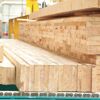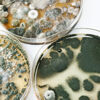
Fresh wood - a paradise for fungi & mould
The latest DIN 68800 Wood Preservation considers the probability of infestation by wood-destroying fungi (rot).
But what about fungi that do not destroy the wood but cause unsightly discoloration or even unsightly and unhealthy growth? This refers to blue stain and fungi. The DIN 68800 states the following in Part 1 Point 1 Scope: “This norm does not address the temporary protection of round wood and cut wood after cutting from discolouring fungi including storage before processing.”
Facts about fungi
Fungi can also develop on dry wood if there is a higher level of moisture on the surface due to high levels of humidity and/or trapped molsture. For instance, the code of practice ‘Prevention of fungi infestation on outdoor coated surfaces’ by the DGfH contains information about the prevention of fungi.
Fungi does not require the high level of wood moisture that rot fungi require for instance, simply a high level of humidity in the surroundings is enough. This automatically increases the moisture on the surface of the wood. In certain circumstances, this opens the gate for fungi. For example, technically dried structural timber is used (including glulam structures and battens) with a wood moisture of 15%.
Relying completely on the technical drying process, some then think they do not need a preventive chemical protection against insects and rot fungi. The subsequent screed and indoor plaster work however increase the relative humidity inside the new building and the wood surfaces, as organic substances, are excellent carrier materials for fungi infestation.
If work is substandard (for instance there is fungi infestation), the builder is confronted with this. The causal relationship with the influence of another trade (e.g. Installation of screed) is of lesser importance here.

What can be done?
Prevention beats being speechless during acceptance any day. Temporary protection against blue stain and fungus is a one approach. Adolit BS 3 offers a temporary protection against the fungus groups. This product is registered with the Federal Institute for Occupational Safety and Health under the number N-57877 and is therefore marketable. It is processed in an immersion process with an application concentration usually of up to 3 % (precise specifications issued by application engineering).
Don’t let building sites become fighting arenas for legal experts. Take action first!
